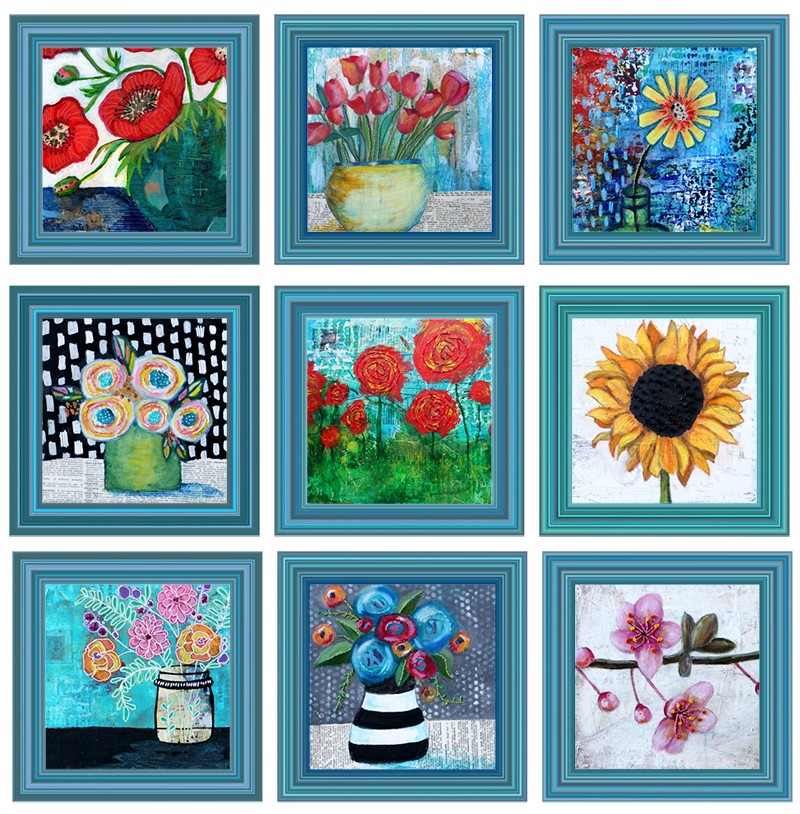This year I am working to paint more loosely in an effort to be more expressionistic. Expressionism is a style of painting, music, or drama in which the artist or writer seeks to express emotional experience rather than impressions of the external world. In effect, it means to try to evoke how the subject made you feel as opposed to trying to paint a realistic replica. As I’ve progressed in my practice, I’ve discovered these 10 tips help me to loosen up immensely. Many of them I demonstrate in this short landscape video below.
Quick Example Video
In this quick video, I loosely paint an expressionistic interpretation of an image I took of the lovely Maroon Bells in Colorado in September 2018. The Maroon Bells are two peaks in the Elk Mountains which provide a stunning view. They are reportedly the most photographed mountains in North America.
Painting Loose Techniques
Tip 1: Work Fast
To paint loose, you have to get out of your head, right? You can’t listen to that inner critic telling you that it doesn’t look right, the color is all wrong, or it’s not as good as what fill-in-the-blank artist does. You can’t spend a lot of time trying to perfect the details or the make the perspective exactly accurate. If you work fast, that inner critic doesn’t have time to talk down to you and your work will not have an iota of tightness to it.
Clearly, in the example, I didn’t paint the Maroon Bells in 3 minutes. However, after the initial coat of orange was dry, I did complete it in just over an hour. I moved quickly and did not give myself time to think. In fact, I did not even know exactly what I was painting until near the end.
Tip 2: Move Around
Move around your substrate as you paint. Keep yourself guessing about what will happen next or what those colors will look like next to each other. If you stay in one spot, it will become tight and overworked. If you move quickly and sporadically around, you will balance your colors and the overall piece will be awesomely loose.
In the example, I moved from top to bottom to middle. I was far from orderly. I allowed the color and my intuition guide me from spot to spot.
Tip 3: Use a Different Paint Brush
What’s your favorite brush? Mine is a size 2 angled brush. Man, I can get some sweet straight lines with that bad boy and fill in some lovely details. That brush is a Marie Kondo joy-sparking instrument for me. We are doing the exact opposite of tidying, though, so whatever you answered, put it down. Don’t use it. Pick up the opposite brush. The one that looks brand new because you’ve never touched it. That’s the one that will force you to paint loose because you can’t wield it with precision. Also, the larger the brush, the looser your strokes will be.
In the example, I grabbed a long 1 inch Simply Simmons brush. I do love this brush when I paint washes over large areas, but then I typically trade it in for smaller and smaller brushes as I get into the details of a piece. Not this time, though — I stuck with the large, long brush for the entire landscape.
Tip 4: Back Your Hand Away
Now that you have a totally different paint brush than you’re used to wielding in your hand, move your hand all the way to the back of it. The longer the better [insert adolescent joke here]. Grab that brush at the tippy top and stay away from your substrate. Holding it far from the bristles makes it more unpredictable how the paint will apply. It’ll make your brushstrokes more energetic and loose.
In the example, I noticed my hand sometimes moved down closer to the paper, but I did pretty well staying at least halfway up the wooden handle as I worked. It would be looser if I was holding it at the top. I’ll work on that.
Tip 5: Don’t Paint With a Brush
Better yet, put your brushes down. Scrape your paint on with an old credit card, gift card, or hotel room key. Paint with your fingers. Drop some acrylic ink straight out of the bottle onto your piece, spray it with water and watch where it drifts. Use a bit of cardboard from one of your thousand Amazon boxes stacked up to be recycled. Take the netting from your bag of oranges, dip it in your paint and start pouncing. The more unique the marks, the looser your work will look.
In the example, it’s hard to tell because the video is sped up so much, but I use a credit card, catalyst texture tool, Faber Castell texture tools, and even a porcupine quill. I know it sounds bizarre, but I use it all the time!
Tip 6: Use Your Non-Dominant Hand
Unless you are one of the odd ambidextrous ones, using your non-dominant hand will make your work looser. Might it look like a kindergartener did some work? It might, but refer to Tip 10 and keep going. It sure as heck won’t be tight.
I didn’t use this technique in the video, but I have used it before and it is very effective.
Tip 7: Use Unrealistic Colors
To be clear, you don’t have to use unrealistic colors to paint loose, but it’s a technique to help you get away from trying to paint realistically. The intent is to help you operate by intuition more than intellect; thus, you’ll produce a looser overall work.
In my example, I clearly use unrealistic colors to depict the Colorado mountain scene. I was also using the vivid colors to depict how the scene made me feel and to set the overall tone of the piece.
Tip 8: Compose With Large Shapes
When you compose with very large shapes, you are unable to get bogged down in the minutia of the scene or subject. So, in effect, the large shapes paired with the large brush strokes and/or mark making tools force you to paint more loosely than if you compose with deliberate small shapes and details.
In my example, after I felt I had sufficiently marked up the landscape, I decided to block in the subject matter. I used a palette knife and put in the large shapes: the mountains, the valley, and the lake. I did attempt to keep the shape of the mountains recognizable, but I composed them quickly as large shapes.
Tip 9: Leave Out the Details
Piggybacking on Tip 8, after you add in your large shapes, at some point you may want to loosely define a subject matter (or not and that’s okay, too). If you DO decide to move beyond the abstract, don’t add in too many details at the end and ruin all your loose hard work. Add the necessary shading and highlighting so that the impression of the subject reads correctly, but don’t add each hair or eyelash.
In the example, I did add the impression of trees near the end, but I attempted to leave it as a suggestion of trees as opposed to very clear tree forms.
Tip 10: Be Open to Happy Accidents
So at this point you are working fast and intuitively, not getting bogged down in the details, moving around the substrate, blocking in large shapes, and using instruments you aren’t familiar with. Congratulations! You’re painting loose! Admittedly, in this fast and loose style, chances are you will make “mistakes.” In this realm and style of painting, though, they aren’t mistakes. They’re happy accidents waiting for you to either turn them into something amazing or paint over them. And because we are so loose at this point, these so-called-mistakes don’t even bother you. Well done, You. Well done.
I hope you enjoyed the quick demo and the techniques. If you have more ideas for how to paint loose, I’d love for you to share them in the comments.








9 Comments. Leave new
HI, Good information, I like to paint but in my mind, I feel that I have to make shapes and sorta match the colors I love art I love to paint just wished I wouldn’t be so OCD about it. but hey I’m going to try some of these tips and see what I create this was awesome.
Thanks, Brenda. A lot of people feel the pressure to be hyper-realistic when they paint or draw. Often times, the imperfections are the best part of art, though. Happy painting!
Love these tips! ‘Loose’ painting is my favorite style, but when I try to create it myself my perfectionism kicks in and I trash early and often! I’m definitely going to follow your suggestions… and mostly stay open to happy accidents. Love your work!
Thanks, Judy. It’s definitely easier said than done, but it’s fun to practice. Don’t trash your work. Paint over it, if you must, but each layer can contribute to the overall piece in the end even if you can barely see it. Plus, I can’t tell you how many times I went to bed hating what I worked on only to wake up and think it wasn’t that bad after all, so maybe try to set it aside and then come back to it later.
Now here are some painting tips I can actually use! I’ve been experimenting trying to capture the magnificence of our beautiful Canadian Rockies, and I just get too in-my-head. Will try these tips today.
Try a palette knife for mountains. It really captures the rocky faces well. Happy painting!
Hi Elizabeth! Expressionism is my absolute favorite art style, but I was always bad at trying to create it because I’m too much of a perfectionist. I’ve been wanting to start painting again so I’ll use your tips to try loose painting. So thanks for the tips! 🙂
Happy painting!
Great tips Elizabeth. I love creating abstracts from my images. So, I love learning about painting techniques. Thanks for introducing me to Expressionism.
Regards
Jen